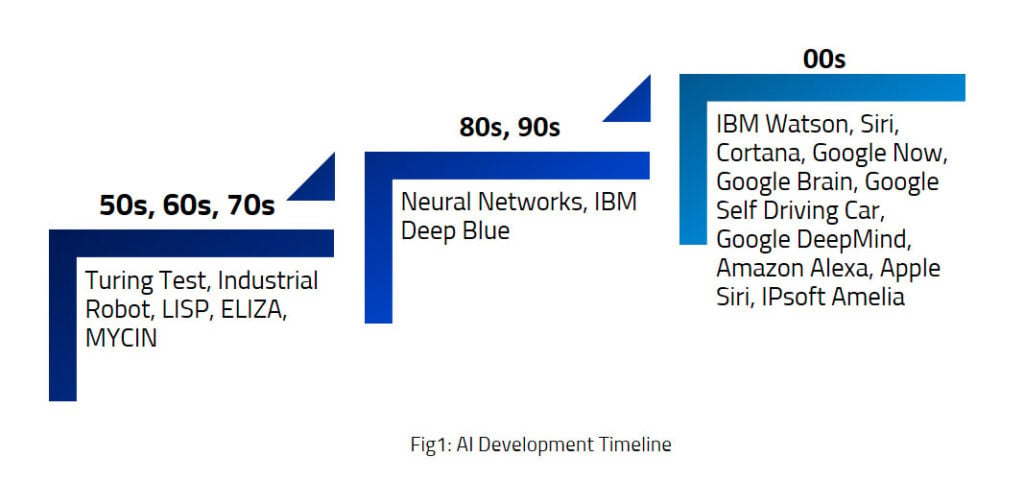1 min read
Most Staffing Firms are Not Built to Scale, But to Survive
Most staffing firms don’t struggle to scale because their teams aren’t working hard. They struggle because they don’t have a real go-to-market...
4 min read
![]() Dan Fisher
:
Jan 29, 2021 10:51:59 AM
Dan Fisher
:
Jan 29, 2021 10:51:59 AM

Artificial Intelligence (AI) has been a fascinating area of learning for several decades now. You didn't realize AI has been around that long did you? Dating back to the 1950s  researchers have experimented with AI applications in a variety of industries including manufacturing, automotive, retail, financial services, and healthcare.
researchers have experimented with AI applications in a variety of industries including manufacturing, automotive, retail, financial services, and healthcare.
Today, many of the products and services we use are already leveraging Artificial Intelligence (AI) to improve the experience. Amazon uses machine learning to recommend products to you based on information it has collected. Google Home, Apple’s Siri and Amazon's Alexa use AI heavily in speech-to-text conversion and optimization. Your email service probably uses AI to fight spam emails and prevent them from landing in your inbox and sorts through your inbox to prioritize which emails to respond to first.
AI can automate mundane tasks allowing humans to engage in higher-value work. Alan Turing, the "father of computer science and AI" had a fundamental question about computers; "Can machines think?" I think we would all agree that this is slowly becoming reality. Note the infographic below provided by Amelia.

Humans started building AI applications with basic and limited intelligence and then broader, general intelligence. Today we are developing AI "super intelligence." As highlighted in the infographic above, we are in the midst of consumer AI-based solutions such as Alexa, Siri, and Google Now, and in particular, more complex, higher-value including the Menemsha Group sales enablement platform recruiters and salespeople love to use for new hire onboarding, training and coaching.
In this blog post, The Impact of AI on Training, Learning & Development, Sales Enablement, I'm going to share with you the role AI has (and will have in the future) on employee training and improving sales and recruiter performance and a few of the ways in which your organization can benefit. But remember, technology and AI and are just one component of the overall sales enablement ecosystem.
The Role of AI in Learning & Development, Sales Enablement
L&D and sales enablement leaders will need to stay on top of the rapidly evolving technology to optimize the learning experience and to develop new learning strategies to leverage all that is possible with AI. A 2019 Gartner report predicted that AI bots would be responsible for servicing 85% of customer service interactions by 2020. When is the last time you called your bank, credit card company, phone service, software or hardware vendor for customer support and didn't interact with an AI bot? Another report states that 20% of business content-including training content- will be written by AI. Finally, a report from Bank of America predicts that AI will drive between $14-33 trillion annually of economic growth by 2025.
AI is going to have a MASSIVE impact on Training, Learning and Development. Organizations have troves of employee, customer, product and services data available to them, which they can analyze and use to optimize training programs.
The days of each employee needing to learn the exact same material as every other employee is quickly fading away. In fact, for most organizations it is a thing of the past. With AI, content can be personalized to suit the individual needs of each learner, focusing on their skill and knowledge gaps. In many cases-such as the Menemsha Group sales enablement platform, AI is already recommending suitable content to the individual learner based on past behavior and performance. It even predicts a learner's training needs based on their role. AI can auto-generate content using various content creation algorithms.
In order for staffing firms to fully utilize AI they need to harness the huge amounts of data required for AI and machine learning to work (of course you need an online training platform as well). It's the data that enables L&D and Sales Enablement leaders to gain the insights they need into the learner journey which helps them create compelling compelling training programs.
Let’s take a look at the way AI is impacting employee training, learning and development.
Learning Styles
An individual's learning style can be influenced by age, ethnicity and cultural background, all of which L&D leaders must factor into the development process. For example, a study by Wainhouse Research found that there are small differences in the way different age groups prefer to learn. People over 50 years of age reported being slightly more interested in coaching and mentoring than other training, learning and development techniques. Millennials on the other hand reported being a little more interested in microlearning, with a preference for short how-to videos.
At a macro-level however, all age groups want face-to-face, live instructor-led training. And contrary to popular belief, millennials want face-to-face training even more than others. Why? Millennials have a constant thirst for learning. Studies have found that the number-one complaint from new hires is lack of learning. They go on to complain that they simply aren’t learning enough, fast enough. New hires also say they would like more hands-on coaching from their managers or peers. AI not only accelerates learning but also frees up time on behalf of L&D leaders to be able to provide more live instructor-led training.
Learning on Demand
Sales Enablement leaders and Training, Learning and Development departments face the need to deliver training anywhere, anytime. Today's staffing professional, salespeople, recruiters and front line managers are overwhelmed at work and struggle to carve out just 1-hour a week to dedicate to training. Rather than shadow an employee for a few hours at a time that is convenient for the employee being shadowed (also hard to do while working remotely) or participating in a live instructor-led training at a time that is conducive for all parties, we need to offer learning on-demand and recommend personalized content to each individual as needed. That is exactly what AI can do. The adoption of artificial intelligence to learn on demand will provide additional speed and accessibility for both L&D leaders and the employees they support.
Personalizing the Learning Experience
As mentioned previously, each of your employees have a preferred learning style and learn most effectively using a specific method. This could be through microlearning video written content, live instructor-led training, gamification, podcasts, or something else.
AI powered training enables your training program to be adaptive, where the learning paths can be modified to suit the needs of each employee's training needs. Your platform might offer video tutorials to certain employees, but auto transcribe the videos to text-based articles for other employees. You may have employees take a certification exam and based on the learner's results AI makes a recommendation for which training content to consume next. This also dramatically shortens the learning process by suggesting only specific modules the employee needs to address the skill and knowledge gaps for the job they are doing.
How is your organization leveraging AI for employee training, learning and development? What steps is your organization taking to make sales enablement a core competency? Learn more in our eBook, The Staffing Leaders Guide to Sales Enablement.

1 min read
Most staffing firms don’t struggle to scale because their teams aren’t working hard. They struggle because they don’t have a real go-to-market...

In my previous post, How to Prevent Unexpected Contract Terminations, I shared how systemizing consultant and client check-ins at key milestones...

About a year ago, I was serving as the fractional revenue leader, managing sales and recruiting for a client.